Mind Streaming
John Coxon's Online Journal|
Archive Search |
| Links |
|
and s-integrator |
Friday, June 27, 2003
OLDSMOBILE CLASSIC
Thursday, June 26, 2003
My only real experience of driving an American car was a Dollar rental "Oldsmobile", a few years back, hired from Orlando airport ; a comfortable steady , maroon coloured automatic saloon with air conditioning and cruise control that took us around the glorious state of Florida in modest but comfortable style.
I was particularly impressed when one of the kids locked the keys in the car (outside a Quality Inn early evening) and this amiable mobile locksmith turned up. He scanned a long number low on the windshield, linked himself by phone or satellite to the Oldsmobile data base and that programmed his key lathe and we had duplicate keys in twenty minutes. Wow.
My second experience was incongruous; on the way home from work, here in down-town Salford, outside a small local engineering shop and garage.
There I saw this chomed and blue and white iconic fifties beauty and stopped to admire and photograph it, despite the ominous, aggresive looking English Bull Mastiff in the open windowed white van parked right next to it. Concourse condition, Oldsmobile, 1956. (Never realised that, like so many classic cars, this one was named after a real person called Mr. Olds) Not much more to say really, just a few photographs. Like so many cars of this era, a classic, a veteran, and an icon of American flare for flashy design that our auto manufacturers tried to emulate with modest success the same decade. Chrome and in your face space ship wings and detail but crude suspension and pretty basic throughout but nice lines of course. Whilst there was an exterior styling that gives romantic nostalgia, these things were hell to ride in, corner in, or heaven forbid, be involved in a collision in . But hey, didn't they look good. I posted some other pictures of this car over on my FOTOLOG
and in fact, set those fotologgers a quiz based on that stunning bonnet/hood ornament that looks like a chrome aeroplane and gave me my photoshot of the day. check it out .
Further Reading :-
Canadian Oldsmobile Club
for history and photo galleries of Olsmobile models.
johncoxon 12:23 AM - [Link] - Comments ()
...
A LOCAL CORNER PUB
Tuesday, June 24, 2003
(THE INSIDE STORY)
When I file-named the jpegs for this little series of shots of a tiny Eccles town pub, I abbreviated the pub name, the Albert Edward, to 'aled' and only just realised I had accidentally made the word for someone who has had a 'skin full' of beer or ale and thus they are 'aled up'. 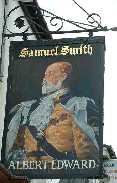
I was walking around Eccles with my camera and was drawn to the distressed looking paint work of what was evidently an original pub, an increasing street rarity anywhere in urban Britain.
( Eccles was formerly one of the five independent boroughs that now make up the city of Salford, and once had its own Town Hall and coat of arms.) The men I spoke to in here didn't like their town being referred as being in Salford, although administratively it is these days. "This is Eccles", they asserted. In the same way, people from Swinton affirm a sense of identity with that town and don't regard the place as Salford. It is a community pride thing amongst, particularly the older generation. 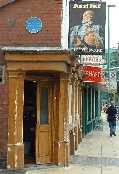
While I was taking photographs of the outside of the pub and the pub sign, the afternoon regulars within eyed me with seemingly friendly amusement and curiosity. "What's all this for ?", one of them asked. "Ah !", I said, " I have some friends in America that I write to and send pictures. They love our English pubs. Also, my dad is called Albert Edward Coxon and I wanted to send him a picture too." At this point I got brave and sought to actually go in and take a few shots, whatever the apparent risk to my personal safety !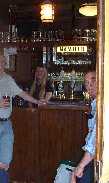
When you take shots of pubs from the outside, people are often curious what you are doing and why. I always say what I'm up to (to allay any suspicions) and ask permission out of courtesy if I am ever challenged. I always enjoy these impromptu conversations, but, there is something else about actually going into an unfamiliar local pub and taking shots unless it is your local, and even then, you have to be aware of privacy issues and be cautious and the prospect of offending someone and getting a knuckle butty ( sandwich /punch) as a reward if you cross some unspoken boundary.
Now I didn't know any of the folks drinking in the pub; they could have been axe murderers and villains for all I knew, but they all seemed friendly enough and prepared to tolerate this weird slightly southern accented bloke, camera in hand. We certainly had a few laughs and I was quite happy that some of the banter / humour was at my expense, because I hoped to get a shot or two of the sacred inside of an unfamiliar but untouched traditional local pub. So I asked if it was O.K. and they were perfectly happy about it. Even so, the shots I took were quite hurried. My lens wasn't wide enough to get the real feel of the place, but even just a taste was something I really wanted to capture.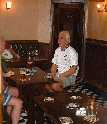
The original vinyl and mahogany settles were in place, though I was told they were due for re-upholstering. The men looked aback when I used this word for the things they called seats. I lamented to them that my old local, the Nelson, in Urmston, owned by a private family brewery that have a lot of the original, traditional pubs in Manchester and its environs are not famous for lavishing huge wads of cash to upgrade their places. This is a mercy because that means the tradition hasn't been torn out of their places, as it hasn't been here. Regarding the re-upholstering, the men weren't holding their breath for exactly when the remote Yorkshire brewery owners of the place would actually do the work, but it had been promised. ( Yorkshire is the adjacent county to Lancashire and separated from us by the Pennine moorlands and hills.)
The floor was the original mosaic of four inch black and white ceramic tiles, like something out of an old Dutch master painting. The walls had that heavy wallpapering (but not the usual floral plain anaglypta )you so often see in older pubs. What you do see is that universal colour of beer pub walls, what i like to call tobacco caramel. Now you can't buy this colour in a paint tin. What you do is decorate in cream and white gloss or emulsion, and then, after a couple of months of intensive patron smoking of cigarettes, 'roll-ups' and the increasingly rare, pipe, the walls magically transform to caramel.
The Albert Edward is a gem of a pub; just one small public bar, even though it is a tad distressed decoratively speaking , inside and out. It is a 'corner' pub, and so the bar is very small but cosy, no bigger than a person's own living room at home. For the patron of the local, this kind of pub can be a home from home. A lot of men spend a lot of time during the week supping their pints of ale in the afternoon after work and through the evenings, (or throughout most of the day, I guess if they are out of work.)
( I called it a beer pub ; it is a working class men's pub. The main source of profit is through the number of pints of bitter and mild beer sold rather than the more expensive shots of different spirits.)
The guys drinking there and affably tolerating my intrusion seemed puzzled that I was so impressed with the interior of the pub and how I said it was great that the place had hadn't been spoiled. "What" , one of them said, "it's a right tip!"(dump) "OK if I take a picture in here", I asked. "No one in here who supposed to be somewhere doing something else?", I quipped ."No you're alright", they said. You'll notice that the bar is quite high, (but its the original) and that, on the shelves behind the barmaid there are mostly just pint pots without handles. There is no evidence of spirits here. You can see that the beer is still hand pumped.
I bid the lads good-bye and began to leave. "Walk up Church Street, round the corner , with that camera in yer hand and see how long you keep it", one of the rough diamonds quipped. "They'll have to take it off me first," I retorted unconvincingly. Looking back and remembering what was a priceless few moments , I couldn't help thinking that the days of this little pub could be numbered and how sad that is. Even small breweries have shareholders and there is a business ruthlessness that cuts out gems of places like this when they don't have a big enough turnover. This pub has an important social function for these patrons. They were decent, friendly blokes , and , however rough and ready the Albert Edward seems, it suits them and it would be a shame to see it go. Some twenty pubs a month are closed, nationally in Britain, I read recently.
johncoxon 10:13 PM - [Link] - Comments ()
...
OUR LOCAL CANALS (Part 1)
Monday, June 23, 2003
A fine pastel drawing, by celebrated local artist, L.S.Lowry, ( see article on Lowry in my alphabetical index links) of a working barge moored atClifton led me to go and take a look at it and perhaps try and find the spot from where he did the drawing. Clifton is a mile from my home, nestled in a low hollow beside the steep banked River Irwell, and around it are a number of industrial businesses still, the biggest being the Pilkington Tile factory, part of which is pictured here. 
In fact the canal and the country park wilderness beside the river are difficult to access from my part of town, unless you have the local knowse, but, upon enquiry, I found that there was a narrow, poorly advertised, rather overgrown public footpath, which presented a tortuous maze of a walk around the long security fenced perimeter of a large newer industrial site. The river was easy to spot,( wet and moving) and lovely it looked , but the old canal proved a challenge to locate .
Then I saw this long , seemingly narrow paved area amidst the vast expanses of weeds and grasses, that ran parallel to, some twenty feet away from, the rear boundaries of a number of factories and industrial businesses.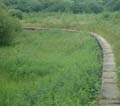
It was obviously the wall edge of the original canal tow path,( the original boats were towed by people or horses) but the canal was now waterless and looked like a giant, endless planter for wild flowers, shrubs, rushes and reeds. Further along, there were the stone rebates where there was once a lock or more likely, a huge wooden barrier was lowered to block off and drain the canal for maintenance. In the long grass, beside the tow path I discovered a lonely milestone bearing the chiseled message "4 M", denoting, possibly, the distance to Manchester or a canal link to the main waterway network ( the Clifton canal being a junction and terminus waterway soley to serve our remote , local factories with a route to their market.)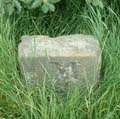
And then, at a point where the canal ran parallel to the railway line (that is still in use,) the canal suddenly 'ran out' and there was evidence that a small aquaduct, under which you could pass, had been destroyed, although, its equally small original twin, a stone tunnel under the railway line, was still intact.( And the image I used for my "Tunnel Vision" posting (Sunday, june 22nd, 2003) , and more clearly shown in the picture I posted on my Fotolog.net pages recently Tunnel
Our region is networked with canals which are still navagable and they are, today, a popular leisure amenity. The majority of what are locally called 'narrow boats', and 'buttys' or barges in other areas of the United Kingdom have been converted to living accomodation and for leisurely canal cruising. They are often decorated with traditonal, richly coloured livery which includes "roses and castles", and flowers. ( I hope to be making a more detailed, specific entry about narrow boats in the near future but have some photographs to take before I can get down to that properly.)
This photograph, I took recently at Eccles , one of the constituent municipal areas of Salford, near Barton-on-Irwell, shows an example of a narrow boat, shorter than the norm in my experience of these waters. At this point on the canal, there once was an innovative stone aquaduct originally built to carry the U.K.'s first ever canal, the Bridgewater Canal, across the River Irwell. The orginal aquaduct has been demolished ( part of it was moved and is still visible as a monument to what was then a remarkable engineering feat ) and superceeded by a cast iron one in Victorian times, when the Irwell had been diverted to allow the construction of the mighty Manchester Ship Canal. That provided the area with open access to the sea at Liverpool and saved huge sums of money in terms of handling and transport costs. Salford became the prosperous dockland for Manchester as a result. The Victorian aquaduct can be seen here in the background and still is very much in everyday use.
The Bridgewater canal was named after the wealthy local landowner, Francis Egerton, the 3rd Duke of Bridgewater. It was designed for him by engineers John Gilbert ( a recent local pub in Worsley is named after him) and James Brindley. It was operational by 1765. A man made waterway to reduce the cost of carrying coal overland, by pack horse, from his underground mines at the Delph in Worsley was he'd deduced, the solution to his transportation problems. Incidentally, the Bridgewater canal is orange in colour, not through pollution, but because of the leaching of iron salts from the original underground coal mine cave system when there is rain. The orginal (Salford area ) canal idea was widely copied throughout the realm in the eighteenth century during the Industrial Revolution where roads were inadequate and the rivers unable to meet the demands of expanding industry.
Further Reading on the Bridgewater Canal and the local coal industry can be found at :-
Local Coal Mining and Canals
and at :-
CANAL JUNCTION
(Canal Junction is the UK's most authoratative and comprehensive web site on our national canal system and its history.)
Apologies for the updated post and unecessary e mail alert as Fotolog.net don't seem to appreciate direct code links to my own photographs on their site. The coding worked in the draft form but came up as restricted when I first published. Sorry)
johncoxon 10:36 PM - [Link] - Comments ()
...
TUNNEL VISION
Sunday, June 22, 2003
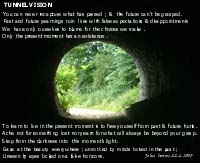
johncoxon 12:14 AM - [Link] - Comments ()
...
ANIMAL FARM
Ryder's farm, Clifton, is now an Equestrian Centre and a very successful business has developed from the original farm, whose picturesque farm house is still occupied by the owners.
The riding school has a number of amiable stock horses but it also has stable space for the mounts of private owners. Naomi and Hannah both have riding lessons there and the education side is well organised. But, standing watching the riders going round in circles in the indoor arena loses its charm after a while and I normally wonder off, as I did today, looking for things that catch my eye to photograph. I have given up trying to take photos in the arena when Naomi has her weekly twilight lesson as the artificial lighting does very strange things to the exposure of my little digital. It isn't fluorescent light, but whatever it is messes up any photograph I take, big time.
This afternoon was one of those glorious sunny English Sundays when time seems to stand still. To live in an urban area and yet have open countryside so close is a real blessing. Today, the first characters I clapped a photographic eye upon were a pair of Pot-Bellied pigs wandering around the stables and munching on the long green grass on the verges. 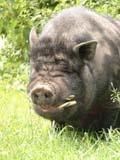
They seemed a tad grumpy, but not dangerous and I lay on the grass to get this , 'in your face' image. Note what looks like a stick the pig is eating. In fact it is either a tusk or one of his mutant teeth. I normally focus on the eyes of an animal but this pigs eyes are resident somewhere under those folds of facial skin.
In the paddock, directly in front of the farmhouse was a white horse( can't understand why they are technically called 'grey' horses) contentedly munching on the grass and from the path way, a convenient tree gave me a framing opportunity with a range of greens and pools of light making a really nice image I thought. I liked the little gate in the picture too, but didn't notice that until I saw the picture enlarged on my lap top.
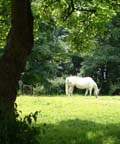
I posted this image over on my FOTOLOG
Next I went out onto the open fields and caught a glimpse of a lovely chestnut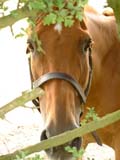
mare through the hedgerow. It was quietly munching away and , irritatingly, was keeping away from the hole in the hedge that would have framed her portrait wonderfully. However, I got something of a nice picture and , on this occasion, It was a really sharp picture and the eyes looked right. You can get some very weird effects with flash in the eyes of different animals. They don't have 'red eye' but green, white or misty blue eye and of course, Photoshop doesn't cover that occurrence as far as I know.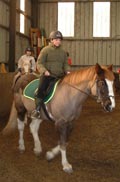
The stables contain a variety of very lovely looking beasts and of course the old stable door ,makes a nice frame for horsey portraits. Here is just one that caught my eye.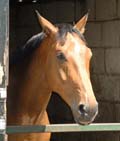
johncoxon 6:29 PM - [Link] - Comments ()
...